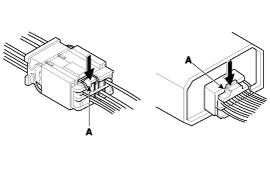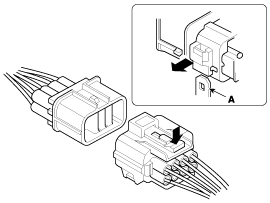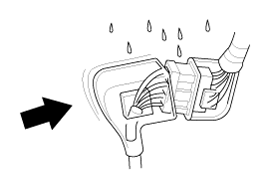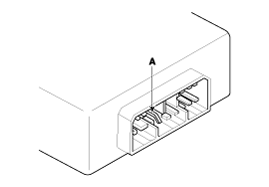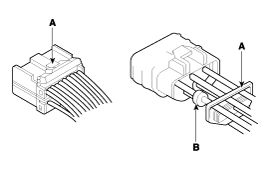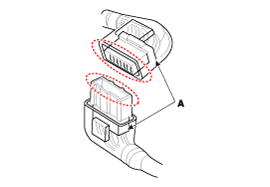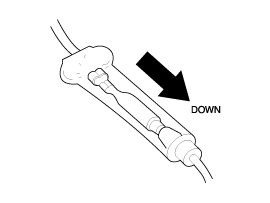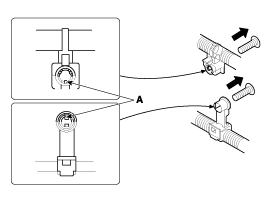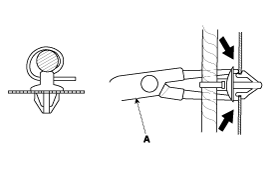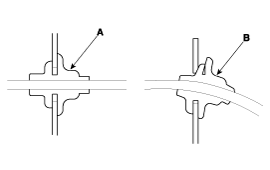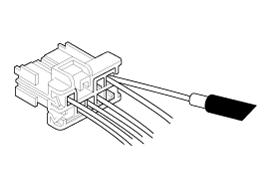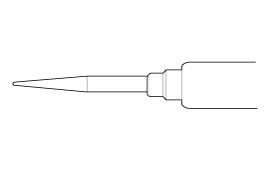Hyundai Creta: General Information / General information
| General Troubleshooting Information |
| 1. |
Check applicable fuses in the appropriate fuse/relay box.
|
| 2. |
Using the battery checker (MCR-570 KIT), check the battery for damage,
state of charge, and clean and tight connections.
(Refer to Engine Electrical System - "Battery")
|
| 3. |
Check the alternator belt tension (D).
|
| 1. |
Make sure the connectors are clean and have no loose wire terminals.
|
| 2. |
Make sure multiple cavity connectors are packed with grease. (except
watertight connectors)
|
| 3. |
All connectors have push-down release type locks (A).
|
| 4. |
Some connectors have a clip on their side used to attach them to a mount
bracket on the body or on another component. This clip has a pull type
lock.
|
| 5. |
Some mounted connectors cannot be disconnected unless you first release
the lock and remove the connector from its mount bracket (A).
|
| 6. |
Never try to disconnect connectors by pulling on their wires; pull on
the connector halves instead.
|
| 7. |
Always reinstall plastic covers.
|
| 8. |
Before connecting connectors, make sure the terminals (A) are in place
and not bent.
|
| 9. |
Check for loose retainer (A) and rubber seals (B).
|
| 10. |
The backs of some connectors are packed with grease. Add grease if necessary.
If the grease (A) is contaminated, replace it.
|
| 11. |
Insert the connector all the way and make sure it is securely locked.
|
| 12. |
Position wires so that the open end of the cover faces down.
|
| 1. |
Secure wires and wire harnesses to the frame with their respective wire
ties at the designated locations.
|
| 2. |
Remove clips carefully; don't damage their locks (A).
|
| 3. |
Slip pliers (A) under the clip base and through the hole at an angle,
and then squeeze the expansion tabs to release the clip.
|
| 4. |
After installing harness clips, make sure the harness doesn't interfere
with any moving parts.
|
| 5. |
Keep wire harnesses away from exhaust pipes and other hot parts, from
sharp edges of brackets and holes, and from exposed screws and bolts.
|
| 6. |
Seat grommets in their grooves properly (A). Do not leave grommets distorted
(B).
|
| 1. |
Do not use wires or harnesses with broken insulation.
Replace them or repair them by wrapping the break with electrical tape.
|
| 2. |
After installing parts, make sure that no wires are pinched under them.
|
| 3. |
When using electrical test equipment, follow the manufacturer's instructions
and those described in this manual.
|
| 4. |
If possible, insert the remover tool from the wire side. (except waterproof
connector)
|
| 5. |
Use a probe with a tapered tip.
Refer to the user's guide in the wiring repair kit (Pub No. : TRK 015.)
|
| 1. |
Verify the complaint
Turn on all the components in the problem circuit to verify the customer
complaint. Note the symptoms. Do not begin disassembly or testing until
you have narrowed down the problem area.
|
| 2. |
Analyze the schematic
Look up the schematic for the problem circuit.
Determine how the circuit is supposed to work by tracing the current
paths from the power feed through the circuit components to ground.
If several circuits fail at the same time, the fuse or ground is a likely
cause.
Based on the symptoms and your understanding of the circuit operation,
identify one or more possible causes of the problem.
|
| 3. |
Isolate the problem by testing the circuit.
Make circuit tests to check the diagnosis you made in step 2. Keep in
mind that a logical, simple procedure is the key to efficient troubleshooting.
Test for the most likely cause of failure first. Try to make tests at
points that are easily accessible.
|
| 4. |
Fix the problem
Once the specific problem is identified, make the repair. Be sure to
use proper tools and safe procedures.
|
| 5. |
Make sure the circuit works
Turn on all components in the repaired circuit in all modes to make
sure you've fixed the entire problem. If the problem was a blown fuse,
be sure to test all of the circuits on the fuse. Make sure no new problems
turn up and the original problem does not recur.
|
| Description |
|
System |
Resetting |
|
Auto up/down window |
Whenever the battery is disconnected, discharged or the related fuse is
replaced or reinstalled, reset the Auto up/down window system according
to the procedure below. 1) Turn the ignition switch to the ON position. 2) Pull up the power window switch in order that the window can close completely, and then keep pulling up the power switch for about 1 second. |
|
Trip computer |
When the battery is disconnected and reconnected, the set functions of the
trip computer become initialized. So, you need to explain this information
to the customer. |
|
Clock |
Whenever the battery terminals or related fuses are disconnected, you must
reset the time in audio head unit. (Refer to Audio owner's manual) |
|
Audio |
When the battery is disconnected and reconnected, the customer's radio stations
become initialized. So, you need to record the customer's radio stations
prior to service, and after service, set the customer's radio stations into
the audio. |
 Special service tools
Special service tools
Special Service Tools
Tool (Number and Name)
Illustration
Application
RKE Battery Checker
(09954-2P100)
...
Other information:
Hyundai Creta GS 2014-2025 Service Manual: Cluster Fascia Panel
Components and components location
Component Location
1. Cluster fascia panel
Repair procedures
Replacement
•
Put on gloves to protec ...
Hyundai Creta GS 2014-2025 Owners Manual: Normal maintenance schedule (Except Mexico) – Gasoline engine
I : Inspect and if necessary, adjust, correct, clean or replace.
R : Replace or change.
*1 : Adjust alternator and power steering (and water pump drive belt) and air
conditioner drive belt (if equipped).
Inspect and if necessary correct or replace.
*2 : Check the engine oil level and lea ...


